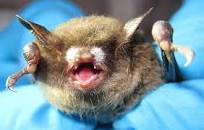
Five million, seven hundred thousand bats have succumbed to white-nose syndrome since 2006. Seven bat species are included in this number: :big brown bats (Eptesicus fuscus), little brown myotis, (Myotis lucifugus), tri-colored bats (Perimyotis subflavus), ), eastern small-footed myotis (Myotis leibii) ,northern myotis (Myotis septentrionalis), the Indiana myotis (Myotis sodalis) and gray myotis (Myotis grisescens). The last two, Indiana myotis and gray myotis are on the endangered species list. The disease is spreading to other species and ultimately 25 species and subspecies of bats could be infected with the disease. According to Bat Conservation International it is possible that, because of the breeding habits of bats, the populations may never return to the levels that were common prior to the introduction of this disease. While bats often live up to 20 years they produce only one offspring per year. It is possible that some affected bat species could be come extinct if the epidemic continues.
The culprit in the case is a fungus known as Pseudogymnoascus destructans. Until this fungus began infecting US bats it was not something that was considered to be important. While the fungus exists among European bats, they do not seem to be as susceptible as American bats. A number of studies have been conducted on what makes bats susceptible in the hope of containing the disease. One study, conducted by scientists at the United States Geological Survey’s Fort Collins Science Center, suggests that environmental conditions in the caves inhabited by the hibernating bats could be responsible for the spread of the disease. The reports suggested that the larger species of bats that tend to hibernate in cooler, drier situations tend to survive better than species such as the little brown bat that prefers more humid caves. While it may prove both a difference in size and environment affects the spread of the disease, this is the sort of information that provides a clue to controlling the disease. Caves that encourage the growth of the fungus could be closed off to the bats, while those less likely to facilitate its growth could be made more accessible.
Researchers with the US Forestry Service in conjunction with Bat Conservation International, The Nature Conservancy and Georgia State University have been working with a native soil bacteria that seems to inhibit the disease. Seventy five bats were captured and placed in wire mesh containers in the caves in which they normally hibernated. They were treated with the airborne components of the bacteria. When they came out of hibernation, while some damage to wings did occur and some were too damaged to release, the survival rate was better than that normal to these caves where death rate was approaching close to 100%.
A study, in its early stages at the University of California, is working with a bacteria that naturally occurs on the skin of some bats, Pseudogymnoascus destructans. The researchers theorize that it might be this bacteria that gives some protection to bat species that are more likely to survive the disease. If test results suggest that this bacteria is indeed effective in fighting off the fungus a field study will spray a test group and check infection rates, survival rates and level of damage. Researchers theorize that if they can get the bats through winter hibernation they will be able to fight off the disease. White-nose syndrome kills by arousing the bats from hibernation prematurely and depleting stored body fat causing death. Another study at Brown University is working on a way to inhibit the enzymes secreted by Pseudogymnoascus destructans that is responsible for the destruction of collagen in the wings of the bats.
Perhaps the most exciting research results come from a study conducted by the US. Forest Service, US. Department of Agriculture and the University of New Hampshire. This group of researchers were studying the genetic structure of Pseudogymnoascus destructans along side the genetic structure of other non-pathogenic Pseudognymnoascus species in an effort to find the key to what made P. destructans lethal. What they discovered was that P. destructans lacked an enzyme sequence necessary to the repair of DNA. They exposed the fungus to a number of DNA destructive agents including UV light. What they found was that using a low level of UV light from a hand held source at an interval of a few seconds 85% of the fungus were killed. Upping the exposure to a moderate level destroyed 99% of the fungus. A study is in the works to test UV light on the little brown bat which is the hardest hit of the species susceptible to white-nose syndrome. Hibernating bats will be treated with the UV-light and survival rates with be noted. Care must be taken to insure that the UV light does not in anyway adversely affect the bats themselves. If this does indeed work it may be the least difficult means of pulling the bat population back from the brink.
